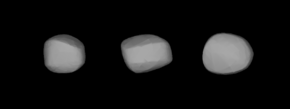astro.wikisort.org - Astéroïde
(69) Hespérie (désignation internationale (69) Hesperia) est un astéroïde de la ceinture principale découvert par le célèbre astronome italien Giovanni Schiaparelli le à Milan. Cet astéroïde a été le seul jamais découvert par cet astronome.
Pour les articles homonymes, voir Hespérie.
(69) Hespérie
(69) Hesperia
(69) Hesperia

Reconstitution de la forme de l'astéroïde par inversion de sa courbe de lumière.
| Demi-grand axe (a) |
446,129 × 106 km (2,982 ua) |
|---|---|
| Périhélie (q) |
372,307 × 106 km (2,489 ua) |
| Aphélie (Q) |
519,952 × 106 km (3,476 ua) |
| Excentricité (e) | 0,165 |
| Période de révolution (Prév) |
1 881,020 j (5,150 a) |
| Vitesse orbitale moyenne (vorb) | 17,13 km/s |
| Inclinaison (i) | 8,589° |
| Longitude du nœud ascendant (Ω) | 185,180° |
| Argument du périhélie (ω) | 290,124° |
| Anomalie moyenne (M0) | 60,810° |
| Catégorie | Astéroïde de la ceinture principale |
| Dimensions | 138,1 km [1] |
|---|---|
| Masse (m) | 2,76 × 1018 kg |
| Masse volumique (ρ) | ~2 000 kg/m3 |
| Gravité équatoriale à la surface (g) | 0,038 6 m/s2 |
| Vitesse de libération (vlib) | 0,073 0 km/s |
| Période de rotation (Prot) |
0,235 6 j (5,655 h) |
| Classification spectrale | M |
| Magnitude absolue (H) | 7,05 |
| Albédo (A) | 0,140 [1] |
| Température (T) | ~159 K |
| Date | |
|---|---|
| Découvert par | Giovanni Schiaparelli |
| Nommé d'après | Hespérie (contrée) |
| Désignation | 1932 CM1, 1945 NB |
Hespérie est un astéroïde de type M.
Schiaparelli l'a nommé Hespérie en l'honneur de l'Italie (le mot est un terme grec pour la péninsule).
Hespérie a été observé par le radar Arecibo en [2].
Références
- IRAS
- (en) Michael K. Shepard, Alan W. Harris, Patrick A. Taylor, Beth Ellen Clark, Maureen Ockert-Bell, Michael C. Nolan et al., « Radar observations of Asteroids 64 Angelina and 69 Hesperia », Icarus, vol. 215, no 2, , p. 547–551 (DOI 10.1016/j.icarus.2011.07.027, Bibcode 2011Icar..215..547S, lire en ligne)
Compléments
Articles connexes
- Liste des planètes mineures (1-1000)
- Ceinture d'astéroïdes
Liens externes
- (en) Caractéristiques et simulation d'orbite de 69 sur la page Small-Body Database du JPL. [java]
- (en) Minor Planet Center database
- Portail de l’astronomie
- Portail des planètes mineures et comètes
На других языках
[de] (69) Hesperia
(69) Hesperia ist ein Asteroid des Asteroiden-Hauptgürtels, der am 29. April 1861 von Giovanni Schiaparelli entdeckt wurde.[en] 69 Hesperia
Hesperia (minor planet designation: 69 Hesperia) is a large, M-type main-belt asteroid. It was discovered by the Italian astronomer Giovanni Schiaparelli on April 29, 1861[1] from Milan, while he was searching for the recently discovered 63 Ausonia.[7] It was his only asteroid discovery. Schiaparelli named it Hesperia in honour of Italy (the word is a Greek term for the peninsula).[8] The asteroid is orbiting the Sun with a period of 5.14 years, a semimajor axis of 2.980 AU, and eccentricity of 0.165. The orbital plane is inclined by an angle of 8.59° to the plane of the ecliptic.[es] (69) Hesperia
(69) Hesperia es un asteroide perteneciente al cinturón de asteroides descubierto el 29 de abril de 1861[nota 1] por Giovanni Virginio Schiaparelli desde el observatorio astronómico de Brera en Milán, Italia. Está nombrado por Hesperia, un nombre griego de la península italiana.[4]- [fr] (69) Hespérie
[ru] (69) Гесперия
(69) Гесперия (лат. Hesperia) — астероид главного пояса, который принадлежит к спектральному классу M. Он был открыт 26 апреля 1861 года итальянским астрономом Джованни Скиапарелли в Брерской обсерватории и назван в честь дочери Нюкты и Океана, одной из гесперид в древнегреческой мифологии. Однако это название также может быть связано с Италией, поскольку древние греки этим термином называли Апеннинский полуостров[3].Текст в блоке "Читать" взят с сайта "Википедия" и доступен по лицензии Creative Commons Attribution-ShareAlike; в отдельных случаях могут действовать дополнительные условия.
Другой контент может иметь иную лицензию. Перед использованием материалов сайта WikiSort.org внимательно изучите правила лицензирования конкретных элементов наполнения сайта.
Другой контент может иметь иную лицензию. Перед использованием материалов сайта WikiSort.org внимательно изучите правила лицензирования конкретных элементов наполнения сайта.
2019-2025
WikiSort.org - проект по пересортировке и дополнению контента Википедии
WikiSort.org - проект по пересортировке и дополнению контента Википедии